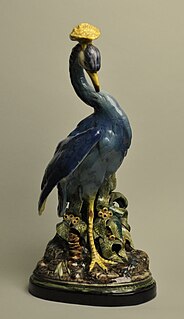
Cemar Clay Products was a California pottery operating between 1935 and 1955. [1] Cemar's art pottery products, including tableware, are sought-after collectables today.

Cemar Clay Products was a California pottery operating between 1935 and 1955. [1] Cemar's art pottery products, including tableware, are sought-after collectables today.
Cemar was founded by Cliff J. Malone and Paul Cauldwell, two former employees of the well-established (J.A.) Bauer Pottery. Cemar Pottery, like Bauer, was based in Los Angeles, California. [2] Cemar was part of the larger boom in California pottery during the World War II era when pottery imports from Asia were restricted or banned; a variety of potteries operated in California to keep up with domestic demand. Cemar was one of 13 members of the California Pottery Guild in 1952. [3]
Cemar's products include giftware, tableware, and garden pottery. [4] Many of Cemar's designs were created by potter Fred Kaye. [5] Many items feature vegetable or fruit designs, or animal designs. Cemar products were produced in many novelty forms, including pineapple-shaped dinnerware. Items were priced at a somewhat higher-end for casual china, selling at around $7.50 for a place setting in 1952. [6]
Cemar's products were featured in numerous women's magazines targeting their marketing towards America's newly affluent middle class housewives: Better Homes and Gardens in 1949; [7] House Beautiful magazine in 1951; [8] and The American Home in 1953. [9] One of Cemar's fish-shaped cookie jars is priced at more than $150 today. [10]
Cemar was bought by Bauer Pottery in the mid-1950s. Bauer reused a number of the molds formerly used by Cemar. [11]
Cemar's products are popular with collectors of California pottery as well as those who look for retro style designs.

Hornsea Pottery was a business located in the coastal town of Hornsea in the East Riding of Yorkshire, England.

The Staffordshire Potteries is the industrial area encompassing the six towns, Tunstall, Burslem, Hanley, Stoke, Fenton and Longton that now make up the city of Stoke-on-Trent in Staffordshire, England. North Staffordshire became a centre of ceramic production in the early 17th century, due to the local availability of clay, salt, lead and coal.
North Dakota in the United States has been the scene of modern era pottery production using North Dakota clays since the early 1900s. In 1892 a study was published by Earle Babcock, a chemistry instructor at the University of North Dakota (UND) that reported on the superior qualities of some of the North Dakota clays for pottery production. The UND School of Mines began operations in 1898 with Earle Babcock as director. With the assistance of several eastern potteries, pottery made from North Dakota clay was first displayed at the 1904 St. Louis World's Fair.

Langley Mill Pottery was located in Langley Mill, Derbyshire on the Derbyshire – Nottinghamshire border. From its establishment in 1865 to its final closure in 1982, the pottery went through five distinct periods of ownership, producing a wide range of stoneware ranging from salt glazed ink bottles, utilitarian items and tableware to high quality and original art pottery.

Royal Doulton is an English ceramic manufacturing company dating from 1815. Operating originally in Vauxhall, London, later moving to Lambeth, in 1882 it opened a factory in Burslem, Stoke-on-Trent, in the centre of English pottery. From the start the backbone of the business was a wide range of utilitarian wares, mostly stonewares, including storage jars, tankards and the like, and later extending to pipes for drains, lavatories and other bathroom ceramics. From 1853 to 1902 its wares were marked Doulton & Co., then from 1902, when a royal warrant was given, Royal Doulton.

Metlox Pottery, strictly speaking Metlox Manufacturing Company, was a manufacturer of ceramic housewares, located at 1200 Morningside Drive, Manhattan Beach, California. The pottery factory closed in 1989.

Carl Romanelli is an American sculptor noted for his many outdoor sculptures of famous people. Romanelli was born and raised in Los Angeles, California. He is a seventh-generation sculptor, and his family is so well known in Italy that a museum there is dedicated to his family's sculptural works.

Blue Ridge is a brand and range of American tableware (dishware) manufactured by Southern Potteries Incorporated from the 1930s until 1957. Well known in their day for their underglaze decoration and colorful patterns, Blue Ridge pieces are now popular items with collectors of antique dishware. The underglaze technique made the decorations more durable, and while basic patterns were reused consistently, the fact that each piece was hand-painted means that no two pieces are exactly alike.
The Homer Laughlin China Company is an American ceramics manufacturer located in Newell, West Virginia, United States, which is best known for producing the Fiesta line of dinnerware. Homer Laughlin is one of two potteries under the HLC Inc. brand, the other being Hall China.

Red Wing pottery refers to American stoneware, pottery, or dinnerware items made by a company initially set up in Red Wing, Minnesota, in 1861 by German immigrant John Paul, which changed its names several times until finally settling on Red Wing Potteries, Inc. in 1936. The pottery factory that started in 1861 continues to the present day under the names of Red Wing Pottery and Red Wing Stoneware. There was a respite in production when Red Wing Pottery Sales, Inc. had a strike in 1967 causing them to temporarily cease trading. The company still makes both zinc/Bristol glazed products as well as salt-glazed, hand-thrown, kiln fired items.

J.A. Bauer Pottery is an American pottery that was founded in Paducah, Kentucky and operated for most of its life in Los Angeles, California.

Gladding, McBean is a ceramics company located in Lincoln, California. It is one of the oldest companies in California, a pioneer in ceramics technology, and a company which has "contributed immeasurably" to the state's industrialization. During the heyday of architectural terra cotta, the company "dominated the industry in California and the Far West."

Franciscan Ceramics are ceramic tableware and tile products produced by Gladding, McBean & Co. in Los Angeles, California, from 1934–1962, International Pipe and Ceramics (Interpace) from 1962–1979, and Wedgwood from 1979-1983. Wedgwood closed the Los Angeles plant, and moved the production of dinnerware to England in 1983. Waterford Glass Group plc purchased Wedgwood in 1986, becoming Waterford Wedgwood. KPS Capital Partners acquired all of the holdings of Waterford Wedgwood in 2009. The Franciscan brand became part of a group of companies known as WWRD, an acronym for "Wedgwood Waterford Royal Doulton." WWRD continues to produce the Franciscan patterns Desert Rose and Apple.

Pacific Clay Products, founded 1892, was created by the merger of several Southern California potteries. The company began producing utilitarian pottery in the 1920s, and introduced solid color earthenware dinnerware in 1932. The primary site for the production of ceramic tableware, kitchenware, and art ware was based in the company's Lincoln Heights, Los Angeles plant at 306 West Avenue 26. Pacific Clay ceased production of ceramic dinnerware and art ware in 1942. After 1942, Pacific Clay produced sewer tile and brick. The company ceased production of sewer tile in 1997. The company continues to produce brick products in Lake Elsinore, California. The company has been owned by David H. Murdock since 1973.

Vernon Kilns was an American ceramic company in Vernon, California. In July 1931, Faye G. Bennison purchased the former Poxon China pottery renaming the company Vernon Kilns. Poxon China was located at 2300 East 52nd Street. Vernon produced ceramic tableware, art ware, giftware, and figurines. The company closed its doors in 1958.

California pottery includes industrial, commercial, and decorative pottery produced in the Northern California and Southern California regions of the U.S. state of California. Production includes brick, sewer pipe, architectural terra cotta, tile, garden ware, tableware, kitchenware, art ware, figurines, giftware, and ceramics for industrial use. Ceramics include terra cotta, earthenware, porcelain, and stoneware products.

The Shawnee Pottery Company was a manufacturing company best known for producing Corn King pottery and the Pennsylvania Dutch lines of pottery. Both of these lines are considered to be highly collectible.

Ironstone china, ironstone ware or most commonly just ironstone, is a type of vitreous pottery first made in the United Kingdom in the early 19th century. It is often classed as earthenware although in appearance and properties it is similar to fine stoneware. It was developed in the 19th century by potters in Staffordshire, England as a cheaper, mass-produced alternative for porcelain.

Brayton Laguna Pottery produced ceramics (pottery) in Laguna Beach, California from 1927 to 1968.

Malibu Potteries was a ceramic tile manufacturer in Malibu, California. Malibu Potteries was founded by Rhoda May Knight Rindge in 1926. A fire devastated the company 30 September 1931, and the company closed in 1932. Tile designs included influences the styles of Moorish, Egyptian, Mayan and Saracen cultures. Many of the tile designs were geometric. The company was known for their tile murals consisting of tiles with peacocks and other birds. The company also produced decorated tiles for floors in the style of a laid-out Persian rug. May Rindge's daughter's house, the historic Adamson House, has many examples of the tile produced by Malibu Potteries.